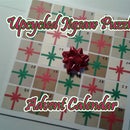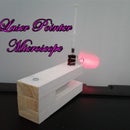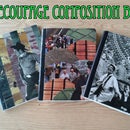Introduction: How to Get an Unlimited Supply of Electronic Components for Under $10.
When I got into electronics finding parts was the biggest challenge. Radio Shack has a decent selection of components for the beginner but their prices are high. Great deals are available online, but the overwhelming variety and unfamiliar jargon makes it a little hard for a novice to know just what to order. I needed a solution.
One day I was taking apart an old printer looking for motors when I looked at the circuit board inside. It was covered in capacitors and resistors but they were all soldered in place with short leads. I used my soldering iron to remove a few caps, but it was slow and awkward. I tried melting the solder in the oven but it stank and softened plastic parts on the board. I needed something with a little more control. I found my answer in the mailbox.
The next morning the mail brought a sales ad for Harbor Freight. Right on the front was a dual temperature heat gun for $7.99! This would be perfect for recovering components. I went down and picked one up. After a little trial and error I figured out the following procedure.
Step 1: Set Up Your Work Area.
Find a place to work that has plenty of ventilation. I usually do this sort of thing outside with a fan blowing to remove the fumes from the melting solder. It helps to work on a board to protect your work surface from splattered solder and burns. Use the appropriate safety equipment, including eye protection, gloves and a respirator. Work carefully and safely.
OK so the 'under $10' in the title is assuming you own a few common tools. First of all you'll need something to gently pry the components out of the board as you melt the solder with the heat gun. I use an old painter tool but any flat, stiff metal tool will suffice. Something stiff and pointy will be useful for working stubborn parts loose or straightening bent leads before removing a part. I use an old needle valve from an outboard engine. A screwdriver will come in handy for removing heat sinks and other components attached with screws. Some sort of wire cutters and needle nosed pliers will also be handy. Finally you'll want a couple of large spring clamps to hold the board you're working on. Don't worry about the tools too much. Nothing is too critical and tools can be substituted or improvised. An old butter knife or artist's palette knife will work just as well to pry the components up. Heavy duty tweezer will work almost as well as needle nose pliers. If you don't have clamps to secure the board to the table you can use vice grips or a c-clamp or even just screw the board to the table through a couple of the board's mounting holes. This is a rough, dirty job so don't use your best tools.
You'll also want to collect some discarded circuit boards to strip of parts. Avoid surface mount (SMD) components. These are almost impossible to reuse. While you can find usable parts in old computers, they tend to have a lot of SMD components. Old computer ATX power supplies are really useful though. Save all of them you can. They make good bench power supplies and you can even use them with a washing soda solution to remove oxidation from metal.
Older stuff is best- radios, VCRs, audio gear, etc. I particularly like old audio mixers. They are a great source of potentiometers, switches and audio jacks. They often have meters, op amps, spring reverb tanks, power transistors, transformers and tons of other usable parts. Old mixers tend to be filthy due to hastily eaten pizzas in the studio, spilled beer at gigs and improper storage. A little attention with a damp cloth with mild detergent, a small, stiff brush and some compressed air will clean things up nicely.
Another great source of parts and components is old organs. You can find them at thrift stores and yard sales for next to nothing. You can often find broken ones for free. I recently acquired a Hammond Aurora for twenty bucks. Aside from the circuit boards with the usual components I also got a spring reverb tank, a Leslie rotating speaker assembly, a foot pedal board, tons of heavy duty rocker switches, pots and switches, a separate discreet amplifier board and more. It also had a Hammond Auto-Vari drum machine! This unit was designed by an engineer from Roland. It has an organic sound similar to the Rhythm King used by Sly Stone and Shuggie Otis with some improvements like a rudimentary pattern sequencer and controls to shape the individual drum sounds. These machine go for a few hundred dollars by themselves for good reason- they sound awesome!
Look for a variety of things to disassemble for parts. Old printers and scanners are a good source of motors. Old smoke detectors are a good source of piezo discs, but discard the leftover parts properly- they contain trace amounts of radioactive americium. Explore and see what you find.
Avoid TV and CRT monitors until you are experienced. They contain high voltage capacitors that can shock and even kill you, even when they have been unplugged for a while. Be very careful when you see large capacitors and If you have any doubts leave them alone. Circuits can bite!
Step 2: It's Getting Hot in Here!
When you have your work area set up and your board mounted firmly you're ready to begin. Start with a smaller, older board to get the hang of the process. Older boards tend to have the components spread out a little more so it's easier to see what you're doing. They also usually have longer leads left on the components which makes reusing them easier.
You will notice that the board has all the components on one side and the solder pads on the other. Turn your heat gun on the low setting and apply heat to the solder side of the board. Start in a corner and keep the heat gun moving in little circles to heat the area evenly. Be careful not to scorch the board or heat the area so much the it melts the components on the other side. Work slowly until you get the hang of it. Keep an eye on the solder. When it starts to liquify gently pry the component from the board. Try to work one component at a time.
I could write all kinds of details, but the best way to learn this is to just do it. You will ruin some parts and you'll make a mess, but eventually you'll get the hang of it. Soon you'll have a pile of stripped boards and a pile of various components. When you're done with the heat gun the fun part begins.
Step 3: Let's See What We Got.
It may sound silly to say to handle the components gently when you've just heated them up and pried them off of a junk board, but use caution when you handle the parts, especially the ICs. Chips can be sensitive to static, especially CMOS devices. Sorting components can be educational- particularly when you're just starting out. You will find all kinds of things that you have no idea what they are. Take the time to figure out what you have. The internet can be helpful. I also recommend Charles Platt's Encyclopedia of Electronic Components. It's jam packed with pictures and explanations of what all those little bits do.
I brought all the parts in and spread them out on the desk to sort. Here's what I ended up with-
84 resistors of various values
55 zero ohm links
15 capacitors invalues from .1uf to 2,200uf.
5 varistors
3 relays
40 assorted diodes
10 transistors (power, darlingtons, basic PNP and NPN)
1 voltage regulator
1 12,000MHz chrystal
2 LM339N quad audio amps
1 CD4051BE multiplexer
1 ULN2003A darlington array
2 JRC324D quad op amps
2 resistor arrays
1 NE555N timer
1 256 bit serial EEPROM
1 8 pin chip socket
1 transformer
several odd pin headers
I also got a 40 pin BHS-1000C mystery chip in a 40 pin socket. 'BHS' stands for Brinks Home Security and the number is the series. This is the 'brain' of the home security system board that I disassembled. A quick search told me that this system covered several security zones and could send alarm signals over the telephone line. I don't know what I'll do with it but it will go into the chip box.
I keep all of my components in metal parts boxes with plastic drawers. I have a lot of components! When you're just starting out a clear plastic tackle box will do. Find a resistor color code chart and a chart of capacitor values and codes to make identifying and sorting parts easier. Print them out and tape them directly on the storage box.
If you want to use your recovered parts on a breadboard you may have to reconfigure your layout due to the components having shorter leads. You may also have to use your soldering iron to remove excess solder so the leads will fit into the breadboad holes. When using circuit boards you may also have to reconfigure your layout. Recycled parts are really useful for 'open' layouts where you solder components directly to other parts, like integrating an R/C circuit into a potentiometer. You may also want to look into Manhattan style layouts where components are soldered directly to individual copper clad plates. Here's an excellent intro to the technique-
http://www.zianet.com/dhassall/advmanart.pdf .
This is a great way to get parts cheaply. It's also a good source for vintage components. For audio circuits some makers swear that vintage components sound better. You'll also come across gems like Nixie tubes and and other 'obsolete' displays. Have fun and remember- with all the money you save on components you can buy a nice soldering station or an oscilloscope.
Now go make something!

Participated in the
Teach It! Contest Sponsored by Dremel

Participated in the
Tech Contest

Participated in the
Fix & Repair Contest







![Tim's Mechanical Spider Leg [LU9685-20CU]](https://content.instructables.com/FFB/5R4I/LVKZ6G6R/FFB5R4ILVKZ6G6R.png?auto=webp&crop=1.2%3A1&frame=1&width=306)





